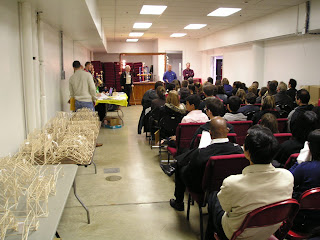




Congratulations to senior Natalie Eggens for her success at the 54th annual Engineering Fair on December 7, 2010 at the South Florida Fairgrounds. Held in conjunction with the Science Fair, this yearly contest is meant to introduce youth to the fun and challenges of civil engineering. For the competition, high school students bring bridges they previously built. Their bridges are strong, efficient, aesthetically pleasing and made of only balsa wood and glue. After the initial judging, each bridge is brought to “The Crusher,” where physics fans watch it tested to the breaking point with a hydraulic press. After crushing their entry, bridges are judged solely by “efficiency”.
THE CRUSHER – an hydraulic bridge tester at the 54th annual Engineering Fair held at the South Florida Fairgrounds on December 7, 2010.
Bridges are to be constructed according to standard specifications to create the most efficient structure. The total mass of the complete bridge must not exceed sixteen (16.0) grams at the time of check-in, and must be made from 3/32-inch square balsa wood and any commonly available glue may be used. To determine a bridge’s efficiency, the applied weight in pounds as shown on the tester is divided by the gram mass of the bridge (for example, a 12 gram bridge that carries only 24 lbs applied is judged more efficient than a 15 gram bridge that carries 50 lbs applied 12/24 = .50 vs. 15/50 = .30).
Natalie’s bridge is the best of this year’s Seminole Ridge students in Mr. Landstrom’s AP Physics B class. Weighing just 14.9 grams, her bridge supported 12.9 pounds before failure. Her bridge is broken, but her brilliant brains are still strong! Our school’s 2nd best bridge was build by senior Mark Blanar, which at 14 grams. This year’s Engineering Fair winner comes from Suncoast High, a bridge which held 65 pounds before breaking Seminole Ridge senior Natalie Eggens (left), and Mark Blanar (right) before at the SDPBC Engineering Fair on December 7, 2010 at the South Florida Fairgrounds.

 Drop It
Drop It Launch It
Launch It Thrill It
Thrill It Arnold Banner
Arnold Banner
 Yiro and Mo
Yiro and Mo Thrill Coasters
Thrill Coasters Mark Blanar and Joseph Pavicic
Mark Blanar and Joseph Pavicic